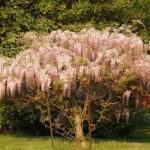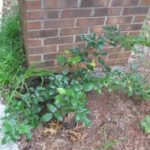One of the more graceful flowering vines that remind me of southern plantations or romantic landscapes is the wisteria. What could be more beautiful as a focal point in your yard than twisted, gnarled stems supporting cascading flowers of white, pink, lavender or purple? There are two species of wisteria. The Japanese wisteria is hardy in USDA zones 4 through 8, while the Chinese wisteria is hardy in zones 4 through 9. The differences between these two vines are the flowers. If you want flowers that open gradually and have longer sprays, choose the Japanese wisteria. But if you are looking for a vine that will give you one big show with the flowers opening all at once, then the Chinese wisteria is the one to choose. The average homeowner can plant and grow wisteria vines.
Wisteria prefers to grow in an area that has full sun exposure. They also need something sturdy to grow against, such as an arbor or trellis away from your home, garage or shed. They can be aggressive vines and if left to grow near a structure or a tree. Even though they look pretty growing against a house or tree, this vine can pry the shingles off a roof. It can also slowly choke a tree or bush to death.
Prepare the Planting Site
Prepare the planting site by removing the vegetation in a three foot area or larger if the root ball is really big. Dig a hole in the center of the cleared area that is two to three times as wide as the wisteria’s container. Keep the planting depth the same as the wisteria’s root ball. With the edge of your spade or shovel, scuff the sides and bottom of the planting hole. This loosens the soil so the roots can penetrate beyond the planting hole.
Amend the soil removed from the hole with 3 to 4 inches of organic compost. The compost does two things for the wisteria vines. It helps with drainage so the roots do not sit in water, and it adds nutrients to the soil that the wisteria vines need to grow.
Plant the Wisteria
Before planting the wisteria, fill the planting hole with water. As the water seeps into the soil, it provides water deep down for the roots to seek out. Allow the water to drain away naturally.
Remove the wisteria’s root ball from the container and place it in the center of the planting hole. Back fill with the amended soil into the hole around the root ball. When the hole is filled hale way, firm the soil in place to remove air pockets. Finish filling in the hole and then tamp the soil in place with your feet.
Watering the Wisteria
Water the wisteria thoroughly. To keep the wisteria growing for the first ear, give them at least an inch of water each week, unless your area has had ample rainfall. After the wisteria is established, only water it if the leaves have wilted.
Mulch
Place a 2 inch layer of organic mulch around the wisteria. The mulch helps retain moisture and keeps the weeds from growing. As it breaks down into the soil, it adds nutrients. Add mulch once a year or more often as it breaks down.
Pruning
If you want to prune your wisteria, do this late in the winter, or very early spring before the buds form. This is also a good time to remove any dead wood or crowded branches. When you prune, cut the side branches, leaving about a foot of growth on the main trunk. Remove any suckers found at the base of the plant. You can also prune wisteria during the summer after it has finished blooming. Trim the new shoots to keep the vine manageable.
Sources:
Washington State University Extension: Gardening in Western Washington
Garden Advice: How to Grow Wisteria
“American Horticultural Society A to Z Encyclopedia of Garden Plants”; Christopher Brickell









